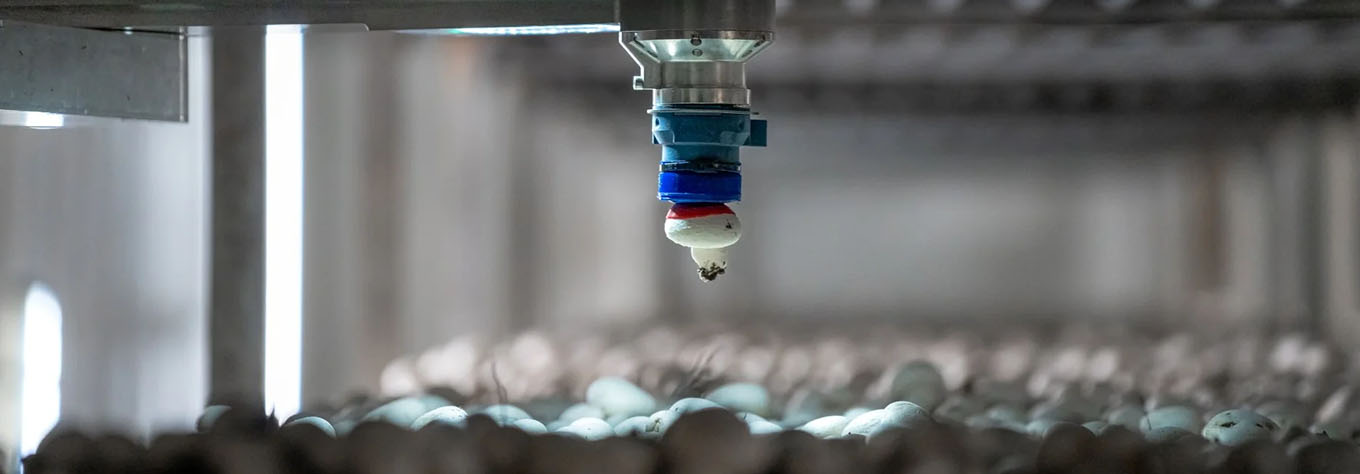-
- North America
- EMEA
Based in Salmon Arm, British Columbia, Canada, 4AG Robotics is revolutionizing the agriculture industry with cutting-edge robotic technology designed to address the labor-intensive nature of farming. Focused on automating the mushroom picking process, 4AG Robotics has made significant strides in the agritech world, earning both recognition and a global customer base in the process.
Since switching their focus entirely to robots harvesting mushrooms in 2020, the company has steadily grown. 4AG Robotics has sold robots to some of the largest mushroom farms worldwide, including those in Ireland, the Netherlands, the U.S., Australia, and Canada. By providing a solution to the labor-intensive task of mushroom picking, 4AG helps farms worldwide scale their operations while simultaneously contributing to sustainability.
Arena PLM and Onshape CAD
A single source of product truth across the entire organization with cloud-connected CAD, PLM, and ERP
Scalable infrastructure for global growth
|
|
Arena PLM and Onshape CAD
A single source of product truth across the entire organization with cloud-connected CAD, PLM, and ERP
Scalable infrastructure for global growth
While their technology is built to address the physical demands of agricultural labor, 4AG Robotics faced another kind of challenge behind the scenes—scaling a complex hardware product in a highly regulated, global industry without a cohesive product design or development infrastructure.
Prior to its rebranding and pivoting to agriculture in 2020, 4AG was a boutique engineering firm handling R&D projects across multiple industries. When the company identified mushroom farming as an ideal candidate for automation—thanks to its controlled environment and chronic labor shortages—they quickly shifted gears and found themselves on a steep growth trajectory. However, there was internal disarray.
“Everything was stored differently, in different places, in different ways,” said Keiran Fitzpatrick, Director of Operations for 4AG Robotics, who joined 4AG Robotics around the time of this strategic pivot. “The mechanical group worked in Onshape, the electrical group used AutoCAD electrical, and software lived in its own silo. Document control was essentially nonexistent. We were flying blind.”
With products evolving rapidly and a supply chain stretching across continents, 4AG needed more than just engineering ingenuity—they needed operational discipline. The lack of a centralized system to manage product record information created bottlenecks in version control, engineering change tracking, and communication across design, manufacturing, and sourcing teams. For a company building high-precision hardware on tight deadlines, the absence of structured product lifecycle management (PLM) and quality management system (QMS) solutions was a risk they could no longer afford.

—Keiran Fitzpatrick, Director of Operations, 4AG Robotics

Having seen the value of PLM systems in previous roles, Fitzpatrick spearheaded the search for a solution that would provide structure without slowing the company’s pace. Arena PLM was a natural fit. “PLM is super integral for any product development company, especially hardware, he said. I had used Arena before, and it was one of the top contenders from day one.”
What sealed the deal was Arena’s connection with Onshape, 4AG’s existing cloud-native CAD solution. The ability to seamlessly connect mechanical design data with the PLM platform was a massive advantage. “The integration meant we weren’t adding friction,” Fitzpatrick explained. “It actually made adoption easier for the mechanical team.”
Implementation began in late 2023, starting with the basics: items, bills of materials (BOMs), and change management. The team went live in early 2024, just in time to support a major design release. While the rollout was a “slow burn” due to competing priorities within the fast-growing startup, Arena quickly became the backbone for all product information.
In addition to the mechanical team, which relies heavily on the Onshape-Arena Connection, the electrical engineering, supply chain, and field services teams were brought into the fold. Arena’s clean and straightforward interface made it easy to train new users, and its cloud-native architecture ensured that the system could scale alongside the business.
Perhaps most critically, 4AG linked Arena to their NetSuite enterprise resource planning (ERP) system to create a fully integrated and automated design-to-manufacturing process. Before the integration, engineers had to manually re-enter data from Onshape into NetSuite—a tedious, error-prone process. Now, BOMs and parts created in Onshape flow directly into Arena and from there released information transfers into NetSuite, eliminating redundancy and vastly improving efficiency.
The company isn’t stopping there. While they started with Arena’s core PLM capabilities, Fitzpatrick already has his eye on accessing advanced capabilities like quality management, compliance tracking, and requirements management. “These aren’t just nice-to-haves—they’re critical for our future,” he said.

The return on investment (ROI) became clear almost immediately. “Hundreds of hours saved—easily,” Fitzpatrick said. “Between the reduction in manual part entry, automated change tracking, and eliminating duplicate work with the integration between Arena and NetSuite, we’re talking about real cost and time savings.”
Previously, engineers relied on memory or emails to communicate design changes to supply chain. Now, Arena’s built-in change management ensures that all stakeholders are notified, aligned, and ready to act. This has helped 4AG avoid costly errors, like manufacturing obsolete parts or scrambling to rework components mid-production.
The Onshape-Arena Connection was another major win. Engineers can sync parts, BOMs, and drawings at the click of a button. “Even compared to what we had at my old company, which used SOLIDWORKS, this is far more streamlined,” said Fitzpatrick. “There’s no exporting, uploading, or manual BOM manipulation. It just works.” That ease of use has helped drive adoption among 4AG’s mechanical and controls teams. “The click-of-a-button simplicity made it much easier to get buy-in,” he noted. “The engineers saw value right away.”
In the field, Arena is the go-to repository for wiring diagrams, part manuals, and support documentation. As 4AG deploys robots across continents, having a centralized source of truth is vital. “It’s not just about the design data anymore. We’re starting to push for more control over ancillary documentation like product requirements and control narratives,” noted Fitzpatrick.
4AG’s strategic plans include rolling out Arena’s quality management module to enforce standards like Conformiteʹ Européenne (CE) and Restriction of Hazardous Substances (RoHS) compliance, as well as using Arena to collaborate with contract manufacturers. “We’re just scratching the surface,” he added. “We haven’t even begun to leverage Arena’s full potential.”
The value of Arena extends beyond internal efficiency. It positions 4AG to better meet global regulatory standards and support international customers with confidence. “We’ve built a solid foundation for scale. Now it’s about expanding that structure to the rest of the organization,” Fitzpatrick explained.
4AG Robotics is growing rapidly in a unique corner of the agritech sector. Their robots operate in environments that produce mushrooms 365 days a year—no seasons, no downtime, just continuous demand. That kind of business model requires robust infrastructure behind the scenes.
With Arena, Onshape, and NetSuite seamlessly connected in the Cloud, 4AG now has that infrastructure. They’ve centralized their product data, automated their workflows, and improved collaboration across engineering, supply chain, and manufacturing.
While their journey with PLM is still evolving, the early benefits are undeniable. “PLM isn’t optional for us,” said Fitzpatrick. “It’s how we make sure our engineering team isn’t reinventing the wheel, how our supply chain isn’t left in the dark, and how we maintain control as we scale.”
As 4AG Robotics continues to push boundaries in agricultural robotics, Arena will remain a key part of their tech stack, providing not just solutions, but a competitive advantage in a global, fast-moving industry.

—Keiran Fitzpatrick, Director of Operations, 4AG Robotics